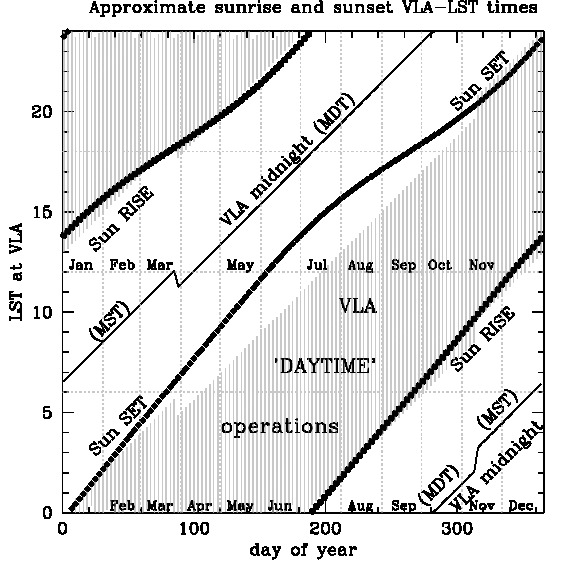Scheduling Considerations
Sessions
Scheduling priorities for the VLA are based on the use of sessions in the PST, which are the units of observing time considered by the Time Allocation Committee. Since the observing priority assigned to a session can strongly depend on how the proposer structures these sessions, we provide a set of guidelines to help you in defining your sessions.
High Frequency
High frequency observations are susceptible to atmospheric effects, such as air turbulence and water vapor. During the summer months, and especially during daytime, conditions appropriate for high frequency observing are limited. Other limitations may include needing night-time observing or observing during dry seasons for increased phase stability. With the stricter weather constraints on high frequency (> 15 GHz) observations, programs are in competition for less available time. Figure 3.1 illustrates a sample plot showing the fraction of available days, as a function of LST, for observing at various bands in April 2011.
|
Figure 3.1: The fraction of days where conditions are suitable for various frequency bands as a function of LST derived from actual data in April 2011. Note the smaller fractions of time available for the higher frequency bands at certain times. Projects requiring LSTs during which this fraction is small for a given band are less likely to be observed. In this particular example, high frequency projects are less likely to be successful in the LST range 0–8h. Note that the available time is further decreased by daytime maintenance activities. We provide summary plots for other months at Monthly Conditions at the VLA. |
For more information on high frequency observations, please see the High Frequency Strategy section of the Guide to Observing with the VLA.
Low Frequency
Observations using the lower frequency bands of the VLA may be adversely affected by Radio Frequency Interference (RFI). There is extensive documentation on RFI at the VLA. Please see the Radio Frequency Interference section in the Guide to Observing with the VLA. Furthermore, such observations may be impacted by solar activities that can cause disturbing ionospheric effects. For more details, see the Low Frequency Strategy and the Very Low Frequency Strategy sections of the Guide to Observing with the VLA.
LST Range
For a number of reasons, the observer might prefer night-time observing over daytime observing:
- During the night, phase stability tends to be better, which is important for high-frequency observing, and there is no solar interference which could affect low-frequency observing.
- There is less time available for observing during the day because of scheduled maintenance and testing on most weekdays, and a session with sources visible only during the day may end up with lower observing priority than when its sources are up during the night.
Figure 3.2 shows the daytime LST range as a function of the day of the year, which can assist you in planning your observations. We note that for moving sources, such as planets, the situation becomes more complex as their LST range suitable for observing tends to vary during the course of the year.
Other considerations to account for are the elevations of the sources within the following limits:
And for programs that require a considerable amount of observing time at a specific LST, how much time is actually available and does the program request more than a few percent of that? More information on times of high and low observing pressure by LST can be reviewed in the Call for Proposals. |
 |
| Figure 3.2: The location of sunrise, sunset, and (shaded) potential test/maintenance time as a function of time of the year and LST. |
Moving Objects
The VLA is able to observe moving objects (solar system bodies) in standard continuum modes as part of general observing. It is not currently possible to observe spectral lines in planets or comets, except in unusual circumstances (background source occultations, for instance), or as part of the Resident Shared Risk Observing (RSRO) program.
Also be aware that during the configuration, moving objects may be observed at LST ranges that are considerably different between the beginning and ending date. Please indicate in the proposal when the optimum date ranges are, and what LST ranges they correspond to. It is beneficial to avoid the high-pressure LST ranges if the object can be observed at other times. For extended objects, also comment on the largest angular scales necessary in the imaging and what date ranges need to be avoided as the object would be too close/large.
For more information on observing moving objects with the VLA, please see the Moving Objects section of the Guide to Observing with the VLA.
Solar Observations
Solar observations typically request that specific types of solar phenomena or activity are present on the solar disk at the time of observations. Assuming that the project has sufficiently high scheduling priority, solar observers must therefore communicate closely with the VLA scheduler to ensure that they are aware when promising targets are available. Solar observations can usually be scheduled 2-3 days in advance.
Sun Avoidance
Throughout the course of the year, the Sun moves across the sky with respect to background objects. Due to the NRAO's use of dynamic scheduling, a scheduling block may end up being observed when the Sun is close enough to have an adverse effect on the data with phase fluctuations and elevated system temperatures.
Please see the section on Avoiding the Sun in the Guide to Observing with the VLA. There is an online tool available to check and see how close your sources are to the Sun and Moon; here is the link to the VLA Sun & Moon Distance Check Tool.




Connect with NRAO